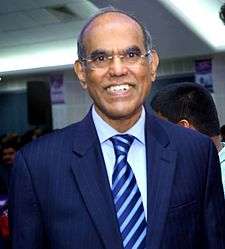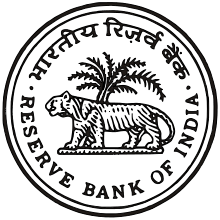Duvvuri Subbarao
Duvvuri Subbarao (born 11 August 1949),[2] is an Indian economist, Central Banker, and retired IAS officer. He was the 22nd Governor of Reserve Bank of India, served under Prime Minister Dr.Manmohan Singh. He lives in Singapore and is a distinguished visiting faculty at National University of Singapore.[3]
Duvvuri Subbarao | |
|---|---|
 | |
| 22nd Governor of Reserve Bank of India | |
| In office 5 September 2008 – 4 September 2013 | |
| Preceded by | Y. V. Reddy |
| Succeeded by | Raghuram Rajan |
| Finance Secretary of India | |
| In office 4 July 2007 - 5 September 2008 | |
| Succeeded by | Arun Ramanathan |
| Personal details | |
| Born | 11 August 1949[1] Kovvuru, Andhra pradesh, India |
| Alma mater | IIT Kharagpur (B.Sc) IIT Kanpur (M.Sc) Ohio State University (MS) Andhra University (Ph.D) |
| Profession | Civil servant, Economist |
| Known for | Governor of Reserve Bank of India |
Subbarao is a 1972 batch Indian Administrative Service (IAS) officer of Andhra Pradesh cadre. He was appointed the 22nd Governor of Reserve Bank of India (RBI) from 5 September 2008, with an extension in 2011 till 4 September 2013.[4]
Early life
Subbarao's hometown is Eluru in West Godavari district, Andhra Pradesh. He did his schooling from the Sainik School in Korukonda, Andhra Pradesh. He graduated in Physics B.Sc Hons. from Indian Institute of Technology Kharagpur (class of 1969).
He received a M.Sc degree also in Physics from Indian Institute of Technology Kanpur.[5] Subbarao topped the Civil Services Examination in 1972 and was assigned the Andhra Pradesh cadre.[6]
In 1978, he did a master's degree in economics from Ohio State University, United States. After a few years, Subbarao joined the Humphrey Fellowship program at Massachusetts Institute of Technology to study Quantitative Economic Modelling. He became a Humphrey Fellow at MIT in 1982.[7] He later received a Ph.D. in Economics from Andhra University.[8] His doctoral thesis was titled "Fiscal reforms at the sub-national level" (1998)
Career
Subbarao, a well known economist is equally well studied in Physics. He had taken physics during his Masters at Indian Institute of Technology as well as for his Civil Services examination. He was the first person to have reviewed Stephen Hawkings's "Brief history of time" in Illustrated weekly, under the title "from here to eternity".
Subbarao worked as the joint secretary in the Department of Economic Affairs, Ministry of Finance,[9] Government of India between 1988 and 1993. Subsequently, he became the Finance Secretary to the Government of Andhra Pradesh between 1993 and 1998. On completion of his term, he was deputed as lead economist in the World Bank from 1999 to 2004. On completion of his term, he was appointed to the Prime Ministers’ Economic Advisory Council from 2005 to 2007 before he was elevated as the Finance Secretary in 2007. On 5 September 2008, he was appointed the twenty-second Governor of Reserve Bank of India (RBI)[6] and Arun Ramanathan was appointed as Finance Secretary on 21 September 2008 in his vacancy.[10] His term was extended for two more years in 2011.[4]
Subbarao was involved in the initiation of fiscal reforms at the state level and had managed a flagship study on decentralisation across major countries of East Asia including China, Indonesia, Vietnam, Philippines and Cambodia.He is credited with financial turnaround of Andhra Pradesh in late nineties when the state had slipped into an unprecedented fiscal crisis[6]
Achievements
During his tenure as Governor of RBI, Dr Subbarao took initiatives for demystification[11] of the Central Bank, including lucid presentation of terse macro economic concepts in the RBI publications and grassroots level interaction with the masses through various financial inclusion, financial literacy and village outreach programmes. He was instrumental in ensuring 100% meaningful financial inclusion in Ernakulam district of Kerala.[12] In February 2012, Subbarao expounded his world-famous theory on the New Trilemma of Central Bankers, which he named as the "Holy Trinity" of price stability, financial stability and sovereign debt sustainability as against Mundell's well known "Impossible Trinity" of fixed exchange rate, free capital flows and independent monetary policy.[13][14] Subbarao's erudite exposition on holy trinity firmly established the Indian perspective[15] in the scholastic debate on the global central banking trilemma.[16]
Dr Subbarao's taking charge as RBI Governor in 2008 was coincident[17] with the outbreak of the Global Financial Crisis.[18] Subbarao is generally credited as having safely stewarded Indian economy through the financial crisis.[19] However, it was during Subbarao's tenure that the value of Indian Rupee tumbled spectacularly, with USD/INR exchange rate for the first time breaching the psychological barrier of 60,[20] and even hitting a new low of 69.
Controversies
Subbarao is known to have a mind of his own and frequently vetoes / overrides the opinion of his fellow members in the Technical Advisory Group on Monetary Policy.[21] He is criticized as lacking democratic spirit by regularly going against majority opinion of fellow experts in the apex level committee.[22]
During Subbarao's last days at the helm of RBI, the banking industry in India was rocked by the infamous Cobra Post expose of money laundering by leading Indian banks through violation of RBI's KYC guidelines, which pointed to the slackness and loopholes in the supervisory role of RBI.[23] Dr Subbarao was also drawn into controversy when a whistleblowing complaint written to him in October 2012 by the noted activist Devidas Tuljapurkar against fraudulent activities of Bank of Maharashtra, was routinely and unthinkingly forwarded by the RBI Governor to the very organisation against which the complaint had been made.[24] This led to alleged and massive harassment of Tuljapurkar (an ex-Director of Bank of Maharashtra) by the bank management, undermining the abject failure of whistle-blowing policy in both RBI and BoM.[25]
Personal life
He is married to Urmila Subbarao.[26][27] They have two sons, Mallik and Raghav, who are both IIT graduates like their father.
Selected works
Subbarao's book, "Who Moved My Interest Rate?: Leading the Reserve Bank of India Through Five Turbulent Years", was published in July 2016.[28][29][30][31]
References
- "Biodata of Duvvuri Subbarao". Archived from the original on 10 February 2009.
- "Civil List". Ministry of Personnel, Public Grievances and Pensions. Government of India. Archived from the original on 18 July 2011. Retrieved 5 September 2008.
- http://www.marketwired.com/press-release/former-india-central-bank-governor-dr-duvvuri-subbarao-appointed-distinguished-visiting-1903853.htm
- "RBI Governor Subbarao gets 2-year extension". indianexpress.com. 9 August 2011. Retrieved 10 January 2012.
- "Dr. D. Subbarao takes over as RBI Governor".
- "Dr Duvvuri Subbarao takes charge as RBI governor". Business Standard. 1 September 2008. Retrieved 5 September 2008.
- "Humphrey Fellowship Program: Duvvuri Subbarao – India".
- Mehra, Puja (20 June 2008). "There Can't Be Painless Adjustments". Businessworld. ABP Pvt. Ltd. Archived from the original on 25 August 2008. Retrieved 5 September 2008.
- "PROFILE - RBI governor Duvvuri Subbarao". Businessweek. 7 November 2012. Retrieved 8 February 2013.
- "Arun Ramanathan appointed Finance Secretary". The Economic Times. 23 September 2008. Retrieved 10 January 2013.
- "Subbarao aims to demystify RBI".
- "Subbarao declares Ernakulam as India's First Financially Included District". The Times Of India.
- "Subbarao on Holy Trinity : speech on February 1, 2012".
- "Duvvuri Subbarao : Policy Challenges from the New Trilemma" (PDF).
- "Views on Subbarao's Trilemma".
- "From Impossible Trinity to Holy Trinity".
- "Duvvuri Subbarao - Article in Arthapedia".
- "Impact of Financial Crisis on India - Collateral Damage & Response" (PDF).
- "Subbarao - A Governor who can hold his own (article in Reuters".
- "Rupee tumbles on RBI's apologetic tone".
- "Minutes of TAC Meeting on April 25, 2013".
- "RBI Governor goes against Majority Decision". Archived from the original on 3 February 2014.
- "RBI response to Cobra Post Exposé".
- Deshpande, Alok (13 June 2013). "Article in The Hindu : To fix whistle blower, bank goes from verse to worse". Chennai, India.
- "Press Club of India :- Victimisation of Tuljapurkar".
- "Biodata of Urmila Subbarao". Archived from the original on 10 February 2009.
- "Subbarao: An officer & a gentleman". The Economic Times. Times Group. 3 September 2008. Retrieved 5 September 2008.
- https://www.amazon.in/Who-Moved-Interest-Rate-Turbulent/dp/0670088927
- http://www.business-standard.com/article/current-affairs/i-paid-the-price-for-asserting-rbi-s-autonomy-subbarao-116071500008_1.html
- http://www.ft.com/cms/s/0/a497adbc-53eb-11e6-9664-e0bdc13c3bef.html
- http://www.livemint.com/Politics/8WUnYsNQMHPHBxaD5i6v9J/Governments-must-show-respect-for-RBI-autonomy-D-Subbarao.html
